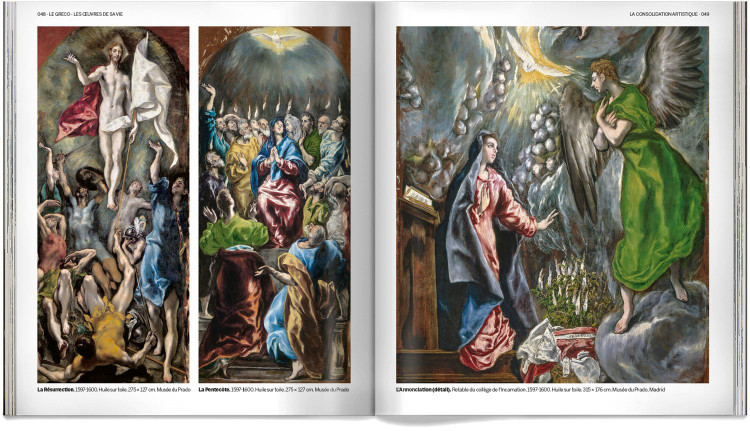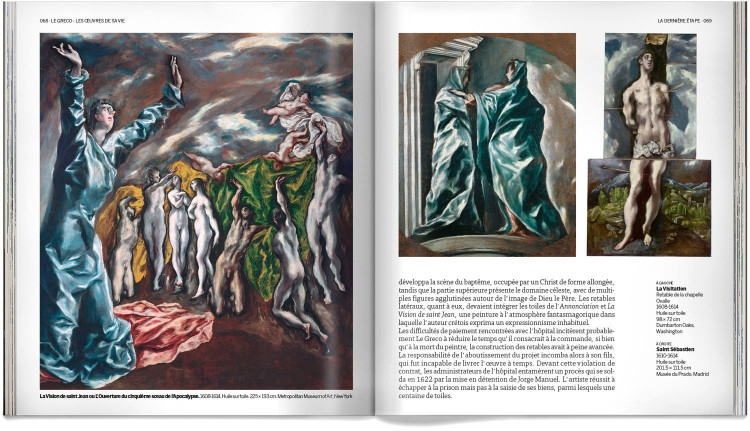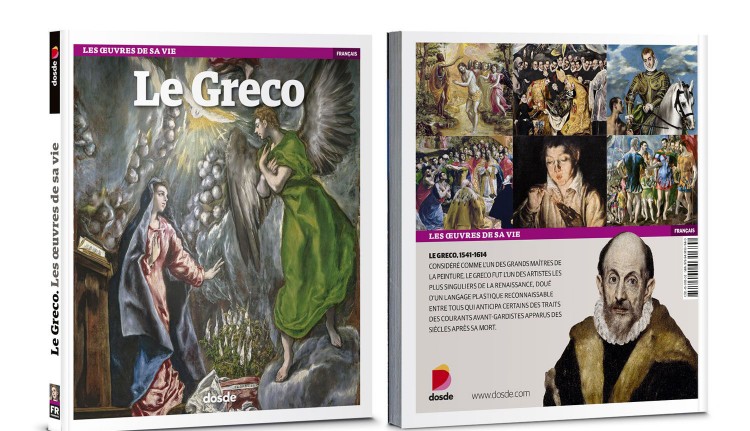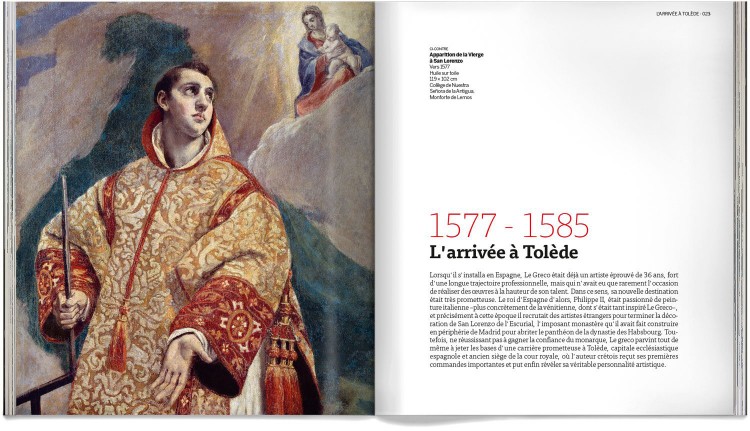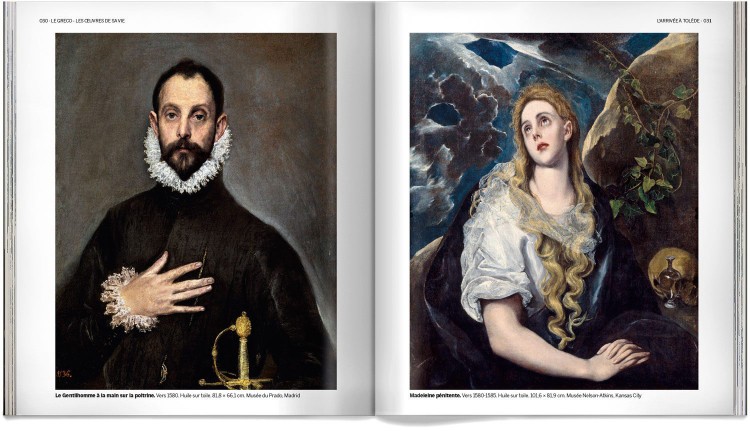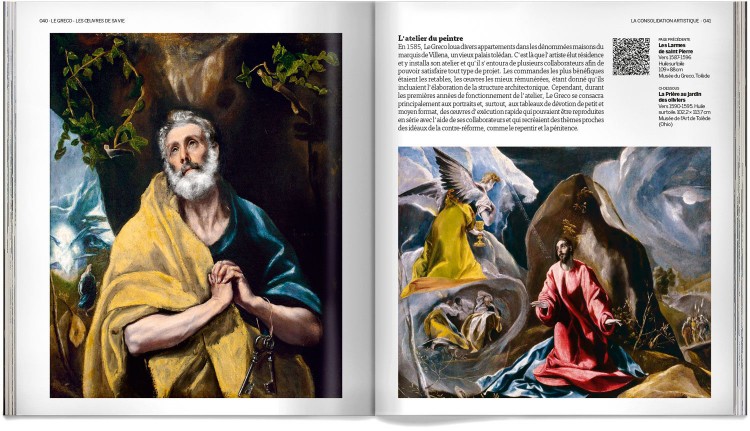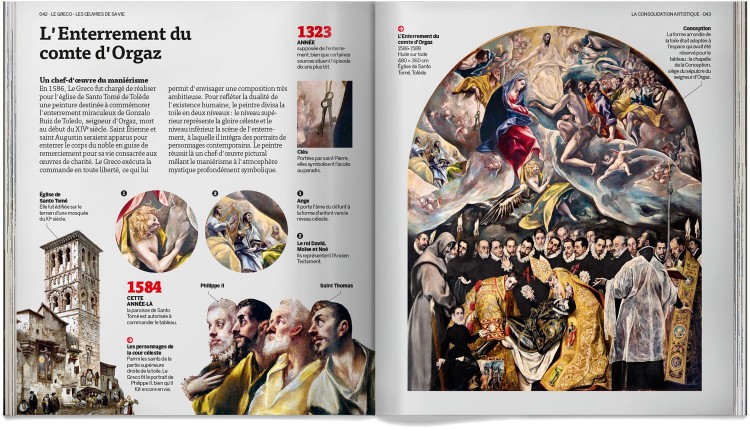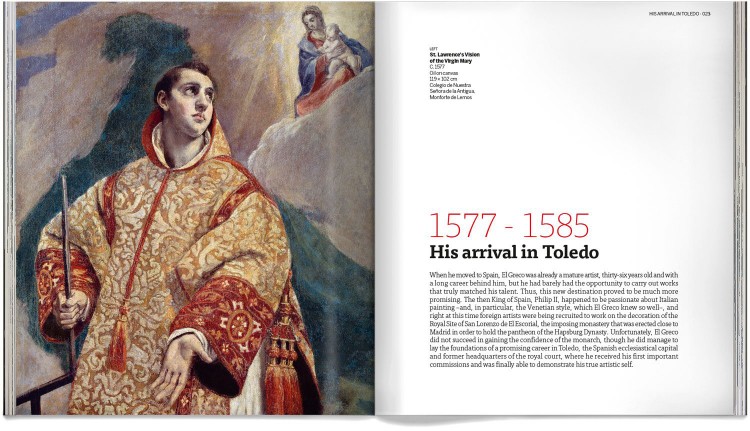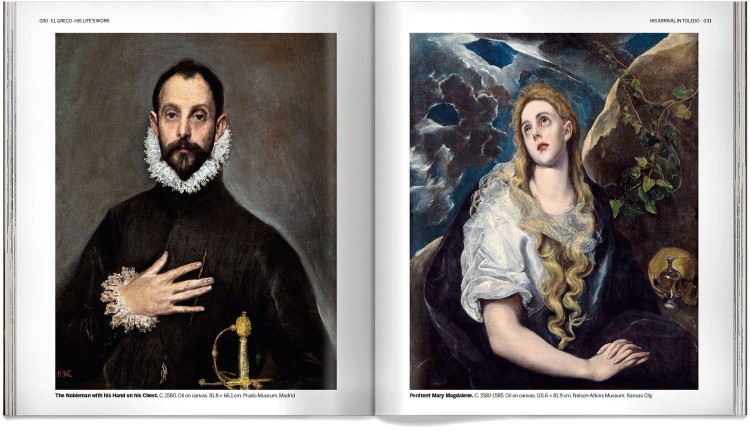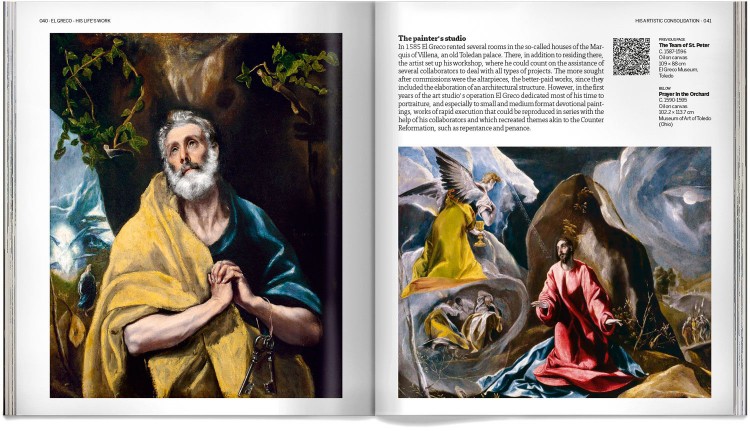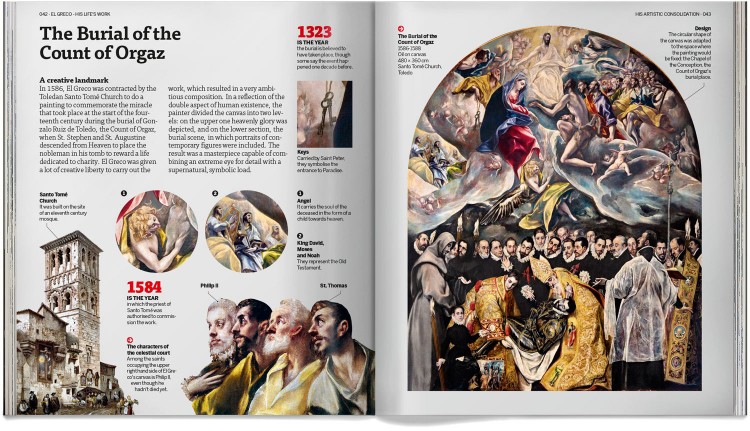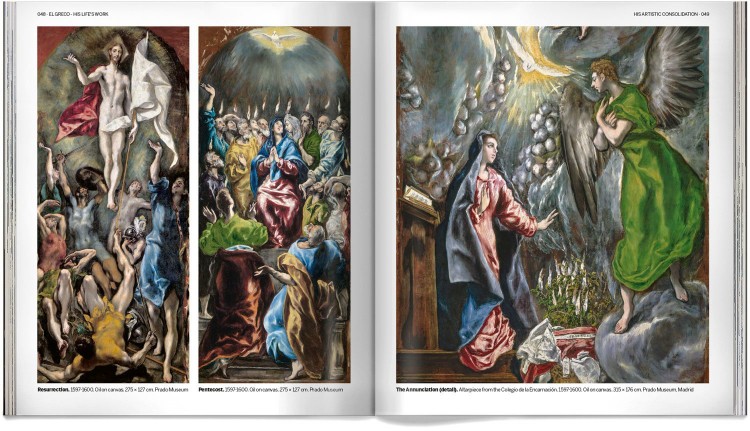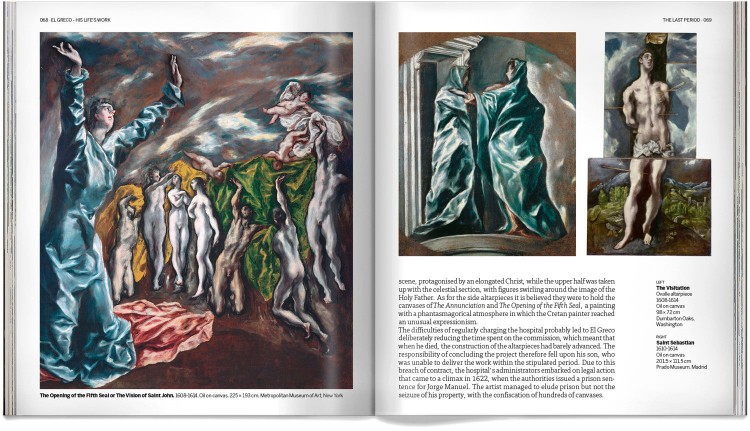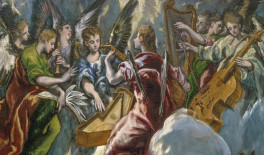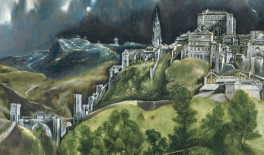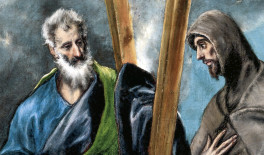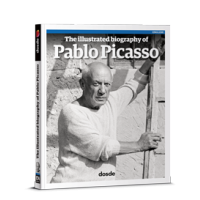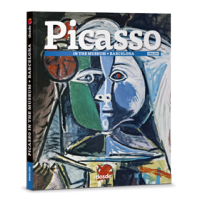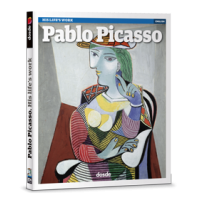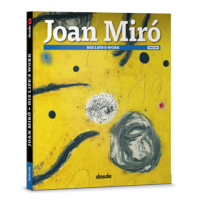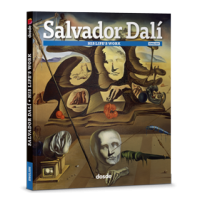El Greco
His life's work
RETURN
About the book El Greco, his life's work
With his unmistakeable style, Doménikos Theotokópoulos, widely known as El Greco, created an original iconographic universe that still remains fully relevant today due to its originality and its evocative power. His paintings boast their own particular style and a technical skill that makes El Greco the most original artist of his time.
El Greco is considered as one of the great icons of the history of art and his evolution started off in Crete and Italy. These places would mark his apprenticeship period, in which he learned how to master the formulas devised by the great masters of Renaissance art, such as Titian and Michelangelo. El Greco would then fall under the influence of Mannerism, of which the artist would carry out an autonomous and personal interpretation, providing the unmistakeable sign of identity to his works.
But it was in Spain, and concretely in Toledo, where the painter reached artistic maturity and carried out the most emblematic works of his career. The Burial of the Count of Orgaz, The Nobleman with his Hand on his Chest or The Assumption of the Virgin are some of the most important paintings by El Greco during this period of artistic consolidation.
This book published by Dosde gathers together El Greco's main works and carries out a detailed study of the painter's evolution, since his formative years in Greece until his consolidation as an artistic genius during his time in Spain. Its pages closely analyse his paintings, the iconography of his paintings and the main characteristics of El Greco's original style. Thanks to this, the reader is provided with a complete portrait of the great Mannerist painter, a unique artist that left an indelible mark on modern art. A book that belongs to our collection of art books.
El Greco is considered as one of the great icons of the history of art and his evolution started off in Crete and Italy. These places would mark his apprenticeship period, in which he learned how to master the formulas devised by the great masters of Renaissance art, such as Titian and Michelangelo. El Greco would then fall under the influence of Mannerism, of which the artist would carry out an autonomous and personal interpretation, providing the unmistakeable sign of identity to his works.
But it was in Spain, and concretely in Toledo, where the painter reached artistic maturity and carried out the most emblematic works of his career. The Burial of the Count of Orgaz, The Nobleman with his Hand on his Chest or The Assumption of the Virgin are some of the most important paintings by El Greco during this period of artistic consolidation.
This book published by Dosde gathers together El Greco's main works and carries out a detailed study of the painter's evolution, since his formative years in Greece until his consolidation as an artistic genius during his time in Spain. Its pages closely analyse his paintings, the iconography of his paintings and the main characteristics of El Greco's original style. Thanks to this, the reader is provided with a complete portrait of the great Mannerist painter, a unique artist that left an indelible mark on modern art. A book that belongs to our collection of art books.
Visual Edition
El Greco
It includes exclusive digital content
Made with environmentally friendly paper
Official licensed product
Multilanguage: available in 6 languages
About the book El Greco, his life's work
With his unmistakeable style, Doménikos Theotokópoulos, widely known as El Greco, created an original iconographic universe that still remains fully relevant today due to its originality and its evocative power. His paintings boast their own particular style and a technical skill that makes El Greco the most original artist of his time.
El Greco is considered as one of the great icons of the history of art and his evolution started off in Crete and Italy. These places would mark his apprenticeship period, in which he learned how to master the formulas devised by the great masters of Renaissance art, such as Titian and Michelangelo. El Greco would then fall under the influence of Mannerism, of which the artist would carry out an autonomous and personal interpretation, providing the unmistakeable sign of identity to his works.
But it was in Spain, and concretely in Toledo, where the painter reached artistic maturity and carried out the most emblematic works of his career. The Burial of the Count of Orgaz, The Nobleman with his Hand on his Chest or The Assumption of the Virgin are some of the most important paintings by El Greco during this period of artistic consolidation.
This book published by Dosde gathers together El Greco's main works and carries out a detailed study of the painter's evolution, since his formative years in Greece until his consolidation as an artistic genius during his time in Spain. Its pages closely analyse his paintings, the iconography of his paintings and the main characteristics of El Greco's original style. Thanks to this, the reader is provided with a complete portrait of the great Mannerist painter, a unique artist that left an indelible mark on modern art. A book that belongs to our collection of art books.
El Greco is considered as one of the great icons of the history of art and his evolution started off in Crete and Italy. These places would mark his apprenticeship period, in which he learned how to master the formulas devised by the great masters of Renaissance art, such as Titian and Michelangelo. El Greco would then fall under the influence of Mannerism, of which the artist would carry out an autonomous and personal interpretation, providing the unmistakeable sign of identity to his works.
But it was in Spain, and concretely in Toledo, where the painter reached artistic maturity and carried out the most emblematic works of his career. The Burial of the Count of Orgaz, The Nobleman with his Hand on his Chest or The Assumption of the Virgin are some of the most important paintings by El Greco during this period of artistic consolidation.
This book published by Dosde gathers together El Greco's main works and carries out a detailed study of the painter's evolution, since his formative years in Greece until his consolidation as an artistic genius during his time in Spain. Its pages closely analyse his paintings, the iconography of his paintings and the main characteristics of El Greco's original style. Thanks to this, the reader is provided with a complete portrait of the great Mannerist painter, a unique artist that left an indelible mark on modern art. A book that belongs to our collection of art books.
No reviews yet.
Additional Information
- Additional Information
- Subtitle: His life's work
- Weight (g): 350
- Binding: Paperback with flaps
- Size (cm): No
- Author: No
- Pages: 0
- Edition: Visual Edition
The early works of El Greco
Throughout his career, El Greco managed to secure a style that was both original and recognisable. The start of his career was marked by his time in Crete, his homeland, and Italy, where the painter learnt to master the techniques characteristic of the Renaissance thanks to his period in Venice and Rome.
During his training on the Greek island of Crete, El Greco specialised in the creation of pictures with a religious theme, that fell in line with the ideals of Byzantine art. Meanwhile, the artist assimilated some of the plastic resources typical of European Renaissance painting. Dating back to this period are works such as The Dormition of the Virgin and St Luke Painting the Virgin, which show Byzantine influence.
Already during his training period in Crete, the painter introduced plastic innovations that anticipated his subsequent change in style, which happened in Italy when studying the techniques typical of the Renaissance and where he could free himself from the restrictions imposed by the canons of Byzantine art.
One of the first works that show his direct contact with Italian painting is the so-called Modena Triptych. It was probably painted in the Italian city of Venice, whose iconography and figurative schemes show western influence, although some Byzantine influence is perceived. El Greco’s stay in Venice turned out to be transcendental for his career. By carefully observing artists such as the likes of Titian and Tintoretto, El Greco could assimilate the typical features of the Venetian school, such as its taste for colour and light and its sense of scenography and dynamism.
His first challenge was to carry out the decoration of the altarpiece of the church in the Monastery of Santo Domingo el Antiguo. In the eight canvases carried out for the temple, the artist combined the best of Venetian and Roman painting, using brilliant colour and an expressive stroke. This project coincided with another major work: The Disrobing of Christ, an enormous canvas created for Toledo Cathedral's sacristy.
These two works allowed him to obtain greater visibility in Toledo, where the painter also developed his skills as a portrait painter. Amongst the well-known portraits by El Greco is The Nobleman with his Hand of his Chest, which converted into the archetype of the 16th century Spanish knight.
One of his masterpieces is The Burial of the Count of Orgaz, commissioned by the Toledan church of Santo Tomé, which has converted into one of El Greco's most famous paintings. The artist was given virtually free rein to carry out the work, which resulted in a very ambitious composition. He divided the canvas into two levels: on the upper one, heavenly glory was depicted, and on the lower section, the burial scene. The result was a masterpiece capable of combining an extreme eye for detail with a supernatural, symbolic load.
The artist's fortune greatly improved in 1596, when those responsible for the Colegio de la Encarnación, in Madrid, commissioned him with what would become the most lucrative altarpiece of his career. In this work we can appreciate a marked chromatic contrast that announces the painter's change in style, with much more emphasis put on the depiction of supernatural elements. The canvases The Annunciation, Resurrection and Pentecost form part of this ensemble. Dating back to this period are the paintings View of Toledo, Saint Martin and the Beggar and Christ with the Cross.
In the last period, El Greco carried out forays into new iconographic themes, such as his purely descriptive representation of Toledo, depicted in the canvas View and Plan of Toledo, which included the first detailed street map of the city, or the only work by the artist dedicated to classical mythology, the canvas Laocoonte.
In his latter years, El Greco also worked on large altarpieces, such as the one commissioned by Toledo Town Hall for the decoration of the Capilla de Ovalle in the Iglesia de San Vicente. The artist created a large altarpiece presided over by the image of the Immaculate Conception, which was completed in 1613, one year before his death. This work is considered as one of El Greco's best works.
During his training on the Greek island of Crete, El Greco specialised in the creation of pictures with a religious theme, that fell in line with the ideals of Byzantine art. Meanwhile, the artist assimilated some of the plastic resources typical of European Renaissance painting. Dating back to this period are works such as The Dormition of the Virgin and St Luke Painting the Virgin, which show Byzantine influence.
Already during his training period in Crete, the painter introduced plastic innovations that anticipated his subsequent change in style, which happened in Italy when studying the techniques typical of the Renaissance and where he could free himself from the restrictions imposed by the canons of Byzantine art.
One of the first works that show his direct contact with Italian painting is the so-called Modena Triptych. It was probably painted in the Italian city of Venice, whose iconography and figurative schemes show western influence, although some Byzantine influence is perceived. El Greco’s stay in Venice turned out to be transcendental for his career. By carefully observing artists such as the likes of Titian and Tintoretto, El Greco could assimilate the typical features of the Venetian school, such as its taste for colour and light and its sense of scenography and dynamism.
El Greco, his arrival in Toledo
By the time he moved to Spain, El Greco was already a mature artist, thirty-six years old and with a long career behind him, but he had barely had the opportunity to carry out works that truly matched his talent. It was in Toledo, the Spanish ecclesiastical capital and former headquarters of the royal court, where he received his first important commissions.His first challenge was to carry out the decoration of the altarpiece of the church in the Monastery of Santo Domingo el Antiguo. In the eight canvases carried out for the temple, the artist combined the best of Venetian and Roman painting, using brilliant colour and an expressive stroke. This project coincided with another major work: The Disrobing of Christ, an enormous canvas created for Toledo Cathedral's sacristy.
These two works allowed him to obtain greater visibility in Toledo, where the painter also developed his skills as a portrait painter. Amongst the well-known portraits by El Greco is The Nobleman with his Hand of his Chest, which converted into the archetype of the 16th century Spanish knight.
The most famous paitings by El Greco
After seeing how his chances of working for Philip II were futile, El Greco was forced to rethink his career and he decided to permanently settle in Toledo. By then the painter already enjoyed certain prestige, and was able to work on perfecting his style, creating diverse works that are considered to be amongst the finest art work of the late sixteenth century.One of his masterpieces is The Burial of the Count of Orgaz, commissioned by the Toledan church of Santo Tomé, which has converted into one of El Greco's most famous paintings. The artist was given virtually free rein to carry out the work, which resulted in a very ambitious composition. He divided the canvas into two levels: on the upper one, heavenly glory was depicted, and on the lower section, the burial scene. The result was a masterpiece capable of combining an extreme eye for detail with a supernatural, symbolic load.
The artist's fortune greatly improved in 1596, when those responsible for the Colegio de la Encarnación, in Madrid, commissioned him with what would become the most lucrative altarpiece of his career. In this work we can appreciate a marked chromatic contrast that announces the painter's change in style, with much more emphasis put on the depiction of supernatural elements. The canvases The Annunciation, Resurrection and Pentecost form part of this ensemble. Dating back to this period are the paintings View of Toledo, Saint Martin and the Beggar and Christ with the Cross.
El Greco's final period
Many of the late works by El Greco consisted of devotional works devised to be reproduced in series by his collaborators. From 1600 the artist introduced a new modality: the apostolates, arrangements comprised of portraits of Jesus Christ and his apostles which were used for ecclesiastical sites.In the last period, El Greco carried out forays into new iconographic themes, such as his purely descriptive representation of Toledo, depicted in the canvas View and Plan of Toledo, which included the first detailed street map of the city, or the only work by the artist dedicated to classical mythology, the canvas Laocoonte.
In his latter years, El Greco also worked on large altarpieces, such as the one commissioned by Toledo Town Hall for the decoration of the Capilla de Ovalle in the Iglesia de San Vicente. The artist created a large altarpiece presided over by the image of the Immaculate Conception, which was completed in 1613, one year before his death. This work is considered as one of El Greco's best works.

